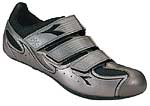Foot pain in cycling shoes is not all that uncommon聴my dogs really start barking sometimes. But that usually isn’t until mile 100 or so on a long Seattle-to-Portland one-dayer or the RAMROD (Ride Around Mount Rainier in One Day) loop. After 20 miles? That’s not so good. But you definitely do not want to wear only a pair of running shoes. Cycling shoes have stiff midsoles that help transfer energy from your legs into the crank and to the wheels. If your shoes “bend” over the pedals, you lose energy. Plus your feet will really hurt.
 Diadora Cosmo
Diadora Cosmo
First thing to do is ensure that your bike fits properly. I can’t give you exact remedies, but you do want to make certain that your legs are comfortably bent at full extension (at the bottom of the pedal stroke) and that your weight is distributed properly between seat and handlebars. A good bike shop should be able to evaluate your riding position very quickly, and make adjustments as necessary.
I’m reluctant to advise you to switch out your entire pedal/shoe setup, but for road bikes I generally prefer a cleat setup (assuming you’re using clipless pedals) with a broad cleat, such as one from Look or Time. I think it distributes the load better than a pedal that uses a smallish, mountain-bike-type cleat. So you might look into that, if you haven’t already: Look’s A3.1 can be had for $100 (www.lookcyclesusa.com), and decent road shoes such as Diadora’s Cosmo go for about $120 (www.diadora.com).
But, and this is a mighty big but, you could be just fine by adding an after-market insole. For me, the Spenco 3/4 Arch Cushions ($17; www.spenco.com) work great, with the abbreviated length ideal for those snugger-fitting cycling shoes. And they offer plenty of support and cushioning across the arch, where pain is most common. So this, plus ensuring proper bike fit, may be two inexpensive solutions with big payoffs. I hope they help, and good luck with the ride!


